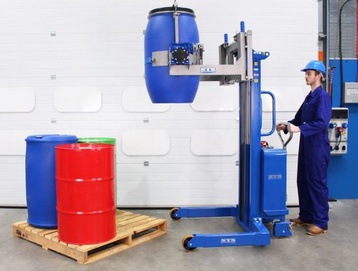Introduction:
Drums are commonly used in industries across the United Kingdom for storing and transporting liquids, powders, and other materials. However, handling drums can be a challenging task due to their weight and bulkiness. Drum handling equipment is designed to streamline and facilitate the handling process, ensuring safety and efficiency. This comprehensive guide aims to provide valuable insights into drum handling equipment in UK, including different types, applications, safety considerations, and maintenance practices.
Importance of Drum Handling Equipment:
Drum handling equipment plays a crucial role in enhancing workplace safety and productivity. Manual handling of drums can lead to various risks, including injuries caused by strains, falls, and spills. By using dedicated drum handling equipment, these risks can be minimized, and the overall efficiency of drum-related operations can be significantly improved.
Types of Drum Handling Equipment:
There are several types of drum handling equipment available in the UK market, designed to cater to different handling requirements. Some commonly used types include:
Drum Lifters: These devices are specifically designed for lifting drums vertically. They often feature adjustable grips or clamps to secure the drum during lifting.
Drum Dollies: Drum dollies are wheeled platforms that allow easy transportation of drums within a facility. They come in various sizes and configurations to accommodate different drum sizes and weights.
Drum Stackers: Drum stackers are versatile equipment that can lift, move, and stack drums vertically. They often include additional features such as adjustable forks and hydraulic lifts for increased flexibility.
Drum Tilters: Drum tilters are used to tilt drums horizontally, allowing for controlled pouring or emptying of the contents. They come in manual or powered versions, depending on the weight and size of the drums.
Drum Dispensers: Drum dispensers are designed to safely dispense liquids or powders from drums. They often feature a spout or nozzle and are commonly used in industries such as chemicals and food processing.
Drum Racks: Drum racks provide secure storage and organization of drums in a vertical position. They are commonly used in warehouses and distribution centers to optimize space utilization.
Applications of Drum Handling Equipment:
Drum handling equipment finds applications in a wide range of industries where drums are used. Some common industries include:
Chemical and Petrochemical Industry: Drum handling equipment is crucial for safely transferring, storing, and dispensing various chemicals and hazardous substances.
Food and Beverage Industry: Drum handling equipment is used to handle drums containing ingredients, additives, and liquids used in food and beverage production.
Pharmaceutical Industry: Drum handling equipment is essential for the safe handling of drums containing pharmaceutical raw materials, intermediates, and finished products.
Manufacturing and Construction Industry: Drum handling equipment facilitates the movement and storage of drums containing lubricants, paints, adhesives, and other materials used in manufacturing and construction processes.
Safety Considerations:
Ensuring the safety of personnel and preventing accidents is of paramount importance when using drum handling equipment. Here are some key safety considerations:
Training: Proper training should be provided to operators on the safe use of drum handling equipment, including load capacity, proper lifting techniques, and understanding safety features.
Weight Capacity: Always adhere to the weight capacity limits specified by the manufacturer. Overloading the equipment can lead to equipment failure and accidents.
Stability: Ensure that the equipment is stable and properly balanced before lifting or moving drums. Uneven weight distribution can cause the equipment to tip over.
Secure Attachments: Use appropriate attachments, such as clamps or grips, to securely hold drums during lifting or tilting operations.
Inspections: Regularly inspect drum handling equipment for any signs of damage, wear, or malfunction. Promptly repair or replace damaged components to maintain safety standards.
Maintenance Practices:
Proper maintenance of drum handling equipment is essential to ensure its longevity and safe operation. Here are some maintenance practices to consider:
Regular Inspections: Conduct routine inspections of the equipment, including all moving parts, hydraulic systems (if applicable), and safety features. Check for leaks, wear, or damage.
Lubrication: Follow the manufacturer's guidelines for lubricating moving parts to ensure smooth operation and prevent premature wear.
Cleaning: Keep the equipment clean and free from dirt, debris, and corrosive substances that may affect its performance or cause damage.
Storage: Store drum handling equipment in a clean, dry area to prevent rusting or degradation. Follow any specific storage requirements provided by the manufacturer.
Conclusion:
Drum handling equipment plays a vital role in ensuring the safe and efficient handling of drums in various industries across the UK. By understanding the different types of equipment available, their applications, safety considerations, and maintenance practices, businesses can optimize their drum-related operations while minimizing the risks associated with manual handling. Investing in high-quality drum handling equipment and providing proper training to operators will contribute to a safer and more productive work environment.


No comments yet